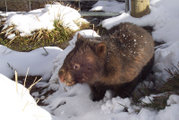Wombat
2008/9 Schools Wikipedia Selection. Related subjects: Mammals
| Wombats Fossil range: Pleistocene to Recent |
||||||||||||||
|---|---|---|---|---|---|---|---|---|---|---|---|---|---|---|
 Common Wombat in the snow
|
||||||||||||||
| Scientific classification | ||||||||||||||
|
||||||||||||||
| Genera and Species | ||||||||||||||
|
Wombats are Australian marsupials; they are short-legged, muscular quadrupeds, approximately 1 metre (39 in) in length with a very short tail. They are found in forested, mountainous, and heathland areas of south-eastern Australia and Tasmania. The name wombat comes from the Eora Aboriginal community who were the original inhabitants of the Sydney area.
Characteristics
Wombats dig extensive burrow systems with rodent-like front teeth and powerful claws. Although mainly crepuscular and nocturnal, wombats will also venture out to feed on cool or overcast days. They are not as commonly seen as many animals, but leave ample evidence of their passage, treating fences as a minor inconvenience to be gone through or under and leaving distinctive cubic scat.
Wombats are herbivores, their diet consisting mostly of grasses, sedges, herbs, bark and roots. Their incisor teeth somewhat resemble those of the placental rodents, being adapted for gnawing tough vegetation, as well as for digging tunnels. Like many other herbivorous mammals, they have a large diastema between the incisors and the cheek teeth, which are relatively simple. The dental formula of wombats is:
| Dentition |
|---|
| 1.0.1.4 |
| 1.0.1.4 |
Dingos and Tasmanian Devils prey on wombats. Their fur colour can vary from a sandy colour to brown, or from grey to black. Each of the species is around 1 m (39 in) in length and weighs between 20 and 35 kg (44 and 77 lb).
Female wombats give birth to a single young in the spring, after a gestation period lasting 26–28 days. They have a well-developed pouch, which the young leave after about 6–7 months. Wombats are weaned after 15 months, and are sexually mature at 18 months of age.
Ecology and behaviour
Wombats have an extraordinarily slow metabolism, taking around 14 days to complete digestion, which aids their survival in arid conditions. They generally move slowly, but when threatened they can reach up to 40 km/h (25 mph) and maintain that speed for up to 90 seconds. Wombats defend home territories centred on their burrows, and react aggressively to intruders. The Common Wombat occupies a range of up to 23 ha (57 acres), while the hairy-nosed species have much smaller ranges, of no more than 4 ha (9.9 acres).
When attacked, they can summon immense reserves of strength; one defence of a wombat against a predator underground is to crush it against the roof of the tunnel, thus suffocating the animal. Its primary defence is its toughened rear hide with most of the posterior made of cartilage. This, combined with its lack of a meaningful tail, makes it difficult for any predator that follows the wombat into its tunnel to bite and injure its target.
Evolution
Wombats, like all the larger living marsupials, are part of the Diprotodontia. The ancestors of modern wombats evolved sometime between 55 and 26 million years ago (no useful fossil record has yet been found for this period). About 11 species flourished well into the ice ages. Among the several rhinoceros-sized Giant Wombat ( Diprotodon) species was the largest marsupial to have ever lived. The earliest human inhabitants of Australia arrived while diprotodons were still common. The Aborigines are believed to have brought about their extinction through hunting, habitat alteration, or probably both.
Species
There are three living species of wombat:
- Common Wombat (Vombatus ursinus)
- Southern Hairy-nosed Wombat (Lasiorhinus latifrons)
- Northern Hairy-nosed Wombat or Yaminon(Lasiorhinus krefftii)
Wombats and humans
They can be awkwardly tamed in a captive situation, and even coaxed into being patted and held, possibly becoming quite friendly. Many parks, zoos and other tourist set-ups across Australia have wombats on public display, and they are quite popular. However, their lack of fear means that they may display acts of aggression if provoked, or if they are simply in a bad mood. Its sheer weight makes a charging wombat capable of knocking an average-sized man over, and their sharp teeth and powerful jaws can result in severe wounds. The naturalist Harry Frauca once received a bite 2 cm (0.79 in) deep into the flesh of his leg—through a rubber boot, trousers and thick woollen socks (Underhill, 1993).
When wombats are kept illegally as pets by people living in rural areas, they can often become a danger to humans. Once the wombat becomes confident in human company, it may lose its fear of humans altogether. This may result in the wombat approaching and attacking a person, which has happened several times in past years. Currently, in central New South Wales, a wombat that once belonged to an elderly woman who passed away is becoming a serious danger to people, as it regularly attacks them when they come into its territory.